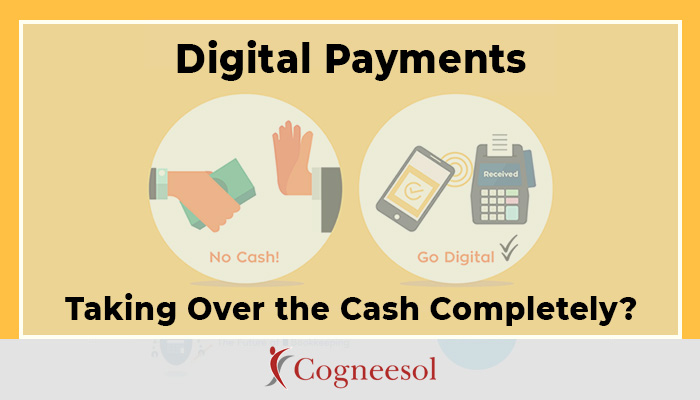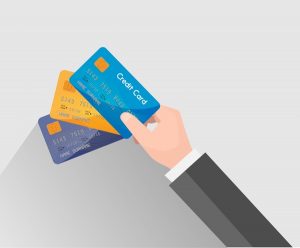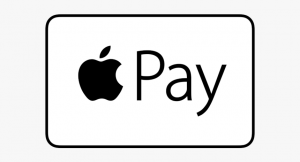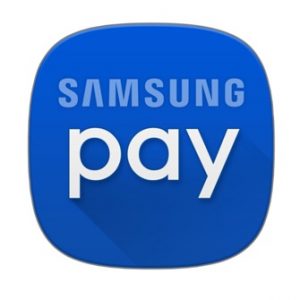
1000+
customers

50+ countries
across the world

Outsourcing leader
since 2008

Technology-driven
services

Stringent
quality processes
Digital Payments Taking Over the Cash Completely?
Last updated: 03 Nov, 2023 By Ashish Rana | 6 Minutes Read

This is 2020! An age which is best described as the age of digitization and modernization. Today, almost everything has gone digital, be it in the private sector or the government sector. One change that has actually created the maximum impact in terms of providing immense benefits and convenience to both the customers and the businesses are the digital payments.
In simple terms, it is an online mode of payment that relies on the transfer of funds between banks electronically. Every country has leveraged the use of digital payments and reaped the benefits associated with the same. So, let’s discuss the change which digital payments have brought in the financial market today.
Types of Cashless Payments
Today, all over the world, people have the option of choosing multiple options for making cashless payments. This is because more and more businesses are going cashless, which, in turn, is making the cashless market more competitive. The following are some of the top options available to the customers for making electronic payments.
Credit Cards
Credit cards are accepted all over the world, and in the US, they are used for almost everything, no matter how small or big the amount is. It is imperative to check the chargeable fees if you are using a foreign credit card in the US as the rates differ for different countries.
| Founded By | Ralph Schneider and Frank McNamara |
| Launched on | 1950 |
Masterpass
Mastercard’s Masterpass is a digital wallet that lets you make the payments without needing you to enter your information every time you make a purchase. With this, you need not worry about the safety of your transactions as your information is stored in a secure and convenient place.
| Founded By | MasterCard |
| Launched on | February 25, 2013 |
Apple Pay
Apple Pay by Apple works on Apple watches, phones to process payments by working with credit card companies, and existing banks. It was launched with the sole purpose of moving the customers away from the world of physical wallets, adding to their convenience eventually.
| Founded By | Apple Inc. |
| Launched on | October 20, 2014 |
Google Pay
Google Pay available on Apple and Android devices, it lets you make payments by working in the same way Apple Pay does (in collaboration with Visa Checkout and PayPal as well). This is one payment option that is fast gaining recognition and acceptance in different parts of the world.
| Founded By | Google Inc. |
| Launched on | September 11, 2015 |
Samsung Pay
With Samsung Pay, you can link credit unions, bank accounts, and credit cards to the app for paying in-person or online. Since Samsung rules the mobile market, a large number of users who own the company’s phone also use the cashless payment service offered by Samsung.
| Founded By | Samsung Electronics |
| Launched on | August 20, 2015 |
PayPal
If we talk about one cashless payment option which has become a brand worldwide, it is none other than PayPal. Available on Android and Apple devices, PayPal offers tap and pay option for in-store purchases and works in the same manner as other digital wallets do.
| Founded By | Elon Musk |
| Launched on | October 3, 2002 |
WePay
With WePay, you can make integrated payments on unique omnichannel software, POS, and online platforms. Businesses can fix transactions and payouts with the sole payment integration using WePay, making the payment process streamlined eventually.
| Founded By | Bill Clerico and Richard Aberman |
| Launched on | 2008 |
Skrill
With Skrill, you can receive and send money, make payments, store cards, link bank accounts using only your password and e-mail address. If you are looking for the best low-cost international money transfer option, Skrill is the name for you.
| Founded By | Lorenzo Pellegrino |
| Launched on | 27 July 2001 |
Payoneer
With more than 4 million users in 200 countries, Payoneer helps you get paid securely, quickly, and at a low cost by foreign clients. It gives you the option to make or receive payments in your Payoneer account and easily withdraw from banks and ATMs.
| Founded By | Yuval Tal |
| Launched on | 2005 |
Amazon Pay
Available across devices and integrating with your existing CRM, Amazon Pay lets you make payments from your Amazon account on different portals for charities, shoppers, and merchants. Since most of the people shop from the Amazon website, having Amazon Pay makes buying and paying effortless.
| Founded By | Amazon |
| Launched on | 2007 |
Backlash and Bans against Cash-Free Businesses
Most of the businesses accept both modes of payments, i.e., cash and online. However, a few of them do not accept cash at all, and these are the ones against whom backlash and bans pop up.
They are of the view that such businesses are trying to create discrimination amongst people who earn less and get paid in cash only like recent immigrants who cannot make digital payments as they do not have access to traditional banking and credit.
Also, the government is taking this on a serious note. With Philadelphia becoming the first US city to ban cash-free businesses, the impact of backlash can be seen to quite an extent.
Top 6 Benefits of Digital Payments
Be it a developed or developing nation, most of the people of every country have started using Smartphones. They are familiar with several mobile apps and use them regularly, with digital payment apps being one of the essential ones. So, what makes digital payments a top choice? Let’s figure out the same.
1. Instant Payment
One of the best benefits associated with digital payments is the fact that they are hassle-free and quick. It doesn’t matter which part of the world you are in; you can make payments easily. With instant notification popping on the phone of the account holder, the authenticity of the transaction gets established.
2. Easy & Quick Setup
If you want to set an option to send and receive digital payments, it is far easier as compared to visiting a bank and then processing the transaction manually. With more and more service providers offering low transaction rates and zero setup fee, the number of people who make use of digital payments is simply on the rise.
3. Competitive Edge
Just as we discussed above that this is the age of digitization, and customers look forward to availing services from a brand that is advanced in every sense. If you provide customers and vendors with the option to receive and send payments, your reputation will be improved in the market, putting you ahead of the competition automatically.
4. Credibility for Merchants
Online software for an invoice which has the features to receive payments online is way more credible and secure for merchants as compared to the payments which they receive in the form of checks. So, the risk of a bounced checks and a high associated fee becomes almost negligible, explains a top provider of accounting software.
5. Recurring Payments
This comes as a blessing for the businesses that offer services that are subscription-based, where the customers have to make the payments after a specific time period. The old procedure of sending reminders and collecting cheques is really tiresome. On the other hand, digital payments make the payment receiving process more streamlined and effortless.
6. Less Chance of a Theft
Anyone can steal your cash. However, it is not easy to steal money digitally, especially, when service providers have the best security systems in place. They ensure a secure transaction and keep hackers at bay. Also, it lets businesses to eliminate theft at the hands of employees at large.
Pros & Cons of the Cashless Society
If we talk about the cashless society concept, it is not a new one. However, the acceptance and implementation of digital payments completely will take some time for sure. A perfect example of this is visible in the form of the replacement of charge cards with credit cards. This took multiple decades. Visa or Mastercard got first acceptance in 1979 by the first national department store (JCPenney).
Businesses that prefer digital payments form an integral part of the cashless society. Moreover, with the people who are wealthy, trust technology and digital security at large. On the other hand, businesses serve diverse clients, in terms of resident and class status, age, and more.
So, in a nutshell, the following are the pros & cons of a cashless society:-
| Pros | Cons |
| Fewer chances of a theft/crime | Exposure of personal information owing to a data breach |
| Fewer chances of money laundering | Chances of account drainage at the hands of hackers |
| Time & cost saving in handling money | Technical problems may eliminate money access |
| Easy exchange of currency during international travels | Not compatible with low earning people in cash |
Conclusion
This is one fact that digital payments are surely changing the way you exchange payments between businesses and customers. However, in order to replace the cash completely, you will need a lot of time. Just like everything else, digital payments too have positives and negatives. However, with improvements in technology and help of the government, negatives of digital payments can become positive.
Cashless society is surely making financial transactions effortless but still multiple hurdles arise in managing the financial processes of businesses. In case you are in the same situation and looking to streamline the financial process of your business? Join hands with Cogneesol to seek complete back-office business accounting solutions for payroll processing, tax preparation, & bookkeeping.
Latest Blogs

This site is protected by reCAPTCHA. Google's Privacy Policy
and Terms of Service apply.


















